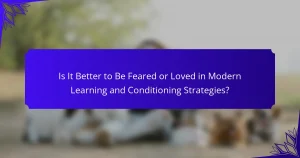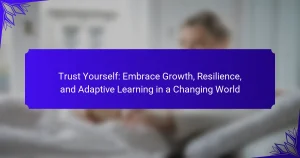Building trust in learning environments enhances communication and collaboration, leading to better engagement and retention. Key strategies include fostering open communication, demonstrating consistency, showing empathy, and encouraging collaboration. Additionally, providing constructive feedback and sharing personal experiences can strengthen connections. Avoiding common pitfalls like lack of transparency is crucial for maintaining a trustworthy educational atmosphere.
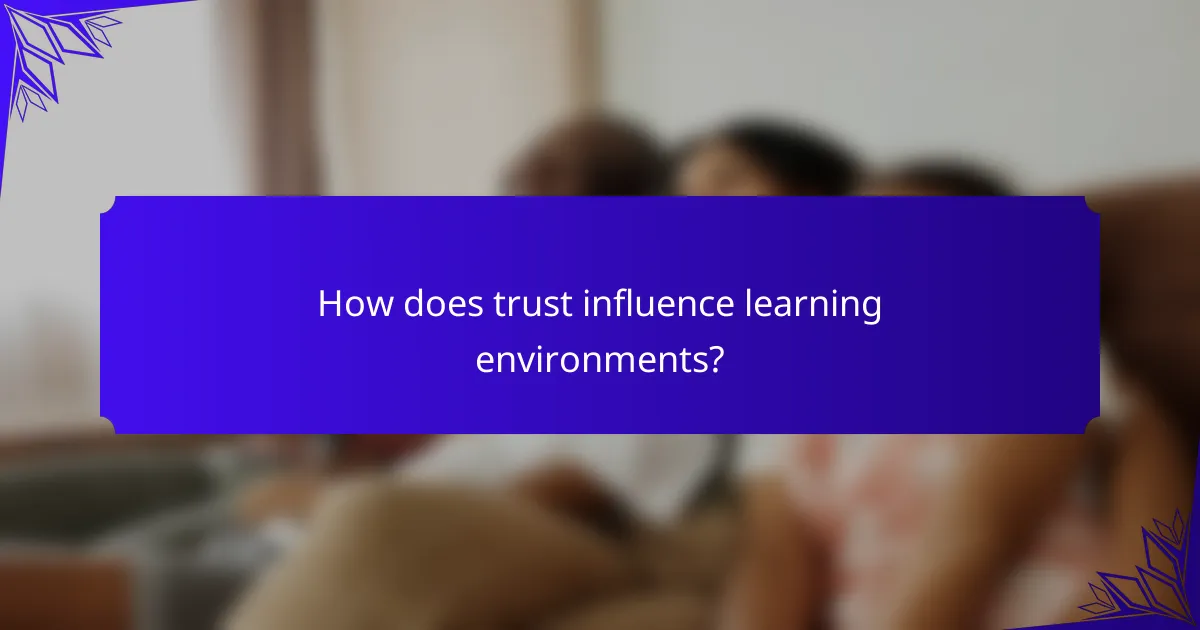
How does trust influence learning environments?
Trust significantly enhances learning environments by fostering open communication and collaboration among participants. When trust is established, learners feel safe to express ideas and take risks, which enhances engagement and retention. Strategies to build trust include creating a supportive atmosphere, encouraging peer feedback, and demonstrating reliability through consistent actions. Research indicates that trust can lead to improved academic performance and increased motivation, making it a vital component of effective learning settings.
What are the key components of trust in educational settings?
Trust in educational settings hinges on communication, consistency, and support. Effective communication fosters open dialogue, allowing students to express concerns and feedback. Consistency in policies and actions builds reliability, while support from educators enhances student confidence. These components create a trusting environment essential for learning.
Why is trust essential for effective conditioning?
Trust is essential for effective conditioning because it fosters a safe learning environment. When learners trust their instructors, they are more likely to engage, take risks, and absorb new information. This trust enhances motivation and promotes open communication, leading to deeper understanding and retention. Research shows that trust increases collaboration and reduces anxiety, which are critical for successful conditioning experiences.
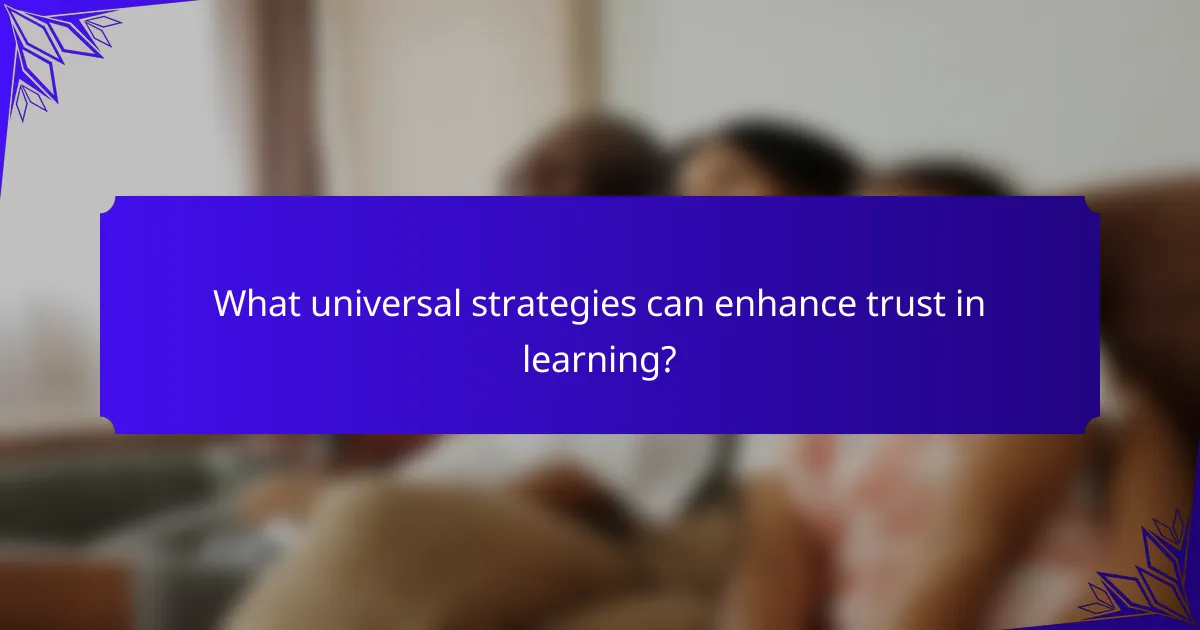
What universal strategies can enhance trust in learning?
Building trust in learning environments requires transparency, consistency, and engagement. Establish clear communication channels to foster openness. Offer consistent feedback to reinforce reliability. Encourage active participation to create a sense of belonging. These strategies cultivate a supportive atmosphere, enhancing trust and promoting effective learning.
How can transparency improve trust?
Transparency fosters trust by promoting openness and accountability in learning environments. When educators share information about processes, expectations, and outcomes, learners feel more secure and valued. This openness encourages engagement and collaboration, leading to a more effective learning experience. Studies show that transparency can enhance student motivation and satisfaction, ultimately improving educational outcomes. By establishing clear communication and sharing feedback, trust builds organically, creating a supportive atmosphere for growth and development.
What practices foster transparency in communication?
Transparent communication practices include active listening, open feedback channels, and regular updates. These practices build trust by ensuring clarity and fostering a sense of belonging. For example, encouraging questions and providing timely responses enhances engagement. As a result, participants feel valued and understood, which is crucial in learning environments.
What role does consistency play in building trust?
Consistency is crucial in building trust as it fosters reliability and predictability. When learners observe consistent behaviors and practices within an educational environment, they feel more secure and valued. This trust encourages engagement and open communication, essential for effective learning. Furthermore, consistent feedback reinforces expectations, enhancing the learning experience. In turn, this cultivates a supportive atmosphere where learners are more likely to take risks and express their ideas. Trust built on consistency ultimately leads to deeper relationships and improved educational outcomes.
How can educators maintain consistency in their approach?
Educators can maintain consistency by establishing clear expectations and routines. This approach fosters a stable learning environment, enhancing trust and engagement. Regular communication and feedback reinforce these practices, ensuring students understand the standards. Additionally, modeling desired behaviors consistently helps students internalize these expectations.
How does empathy contribute to trust-building?
Empathy is essential for trust-building as it fosters genuine connections. When individuals feel understood and valued, they are more likely to engage openly. This emotional resonance creates a safe environment for sharing ideas and feedback, enhancing collaboration. Empathy also encourages active listening, allowing educators and learners to address concerns effectively, further solidifying trust.
What are effective ways to demonstrate empathy in learning?
Demonstrating empathy in learning involves active listening, validating feelings, and fostering a supportive environment. These strategies build trust and enhance engagement.
Active listening allows educators to fully understand students’ perspectives. This involves giving undivided attention and responding thoughtfully. Validating feelings acknowledges students’ emotions, making them feel heard and respected.
Fostering a supportive environment encourages open communication. Creating safe spaces for sharing experiences promotes vulnerability and connection. These practices lead to stronger relationships and improved learning outcomes.

What unique strategies can be employed for trust-building?
Building trust in learning environments requires unique strategies that foster genuine connections. Establishing clear communication, demonstrating consistency, and showing empathy are essential.
1. Foster Open Communication: Encourage dialogue where learners feel safe sharing thoughts, enhancing trust through transparency.
2. Demonstrate Consistency: Maintain reliable actions and responses to build predictability, crucial for trust.
3. Show Empathy: Understand and acknowledge learners’ feelings, which strengthens relational bonds.
4. Encourage Collaboration: Promote teamwork and peer interaction, creating a community that supports trust-building.
5. Provide Constructive Feedback: Offer guidance that helps learners grow, reinforcing trust in your support.
6. Share Personal Experiences: Relate your own learning journey to establish authenticity and connection.
How can personalized learning experiences enhance trust?
Personalized learning experiences can significantly enhance trust by fostering individual connections and addressing unique learner needs. When learners feel understood and valued, their confidence in the educational environment increases. Tailored feedback and support create a sense of safety, encouraging openness and engagement. This personalized approach builds a strong foundation of trust, essential for effective learning.
What are the best practices for creating personalized learning paths?
To create personalized learning paths, focus on understanding individual learner needs and preferences. Assess their goals, strengths, and weaknesses. Incorporate adaptive learning technologies that adjust content based on performance. Encourage learner autonomy by allowing choices in topics and resources. Use continuous feedback loops to refine paths and enhance engagement.
What innovative technologies can support trust in learning?
Innovative technologies that support trust in learning include blockchain, artificial intelligence, and virtual reality. Blockchain ensures secure record-keeping, enhancing transparency in credential verification. Artificial intelligence personalizes learning experiences, fostering engagement and accountability. Virtual reality creates immersive environments that build confidence through experiential learning.
How can platforms like online learning communities foster trust?
Online learning communities can foster trust by promoting transparency, engagement, and support. Clear communication of expectations and guidelines builds a sense of safety. Regular interaction between members encourages collaboration and strengthens relationships. Providing timely feedback enhances accountability, while recognizing contributions fosters a sense of belonging. Lastly, creating a culture of respect and inclusivity ensures all voices are valued, further solidifying trust within the community.
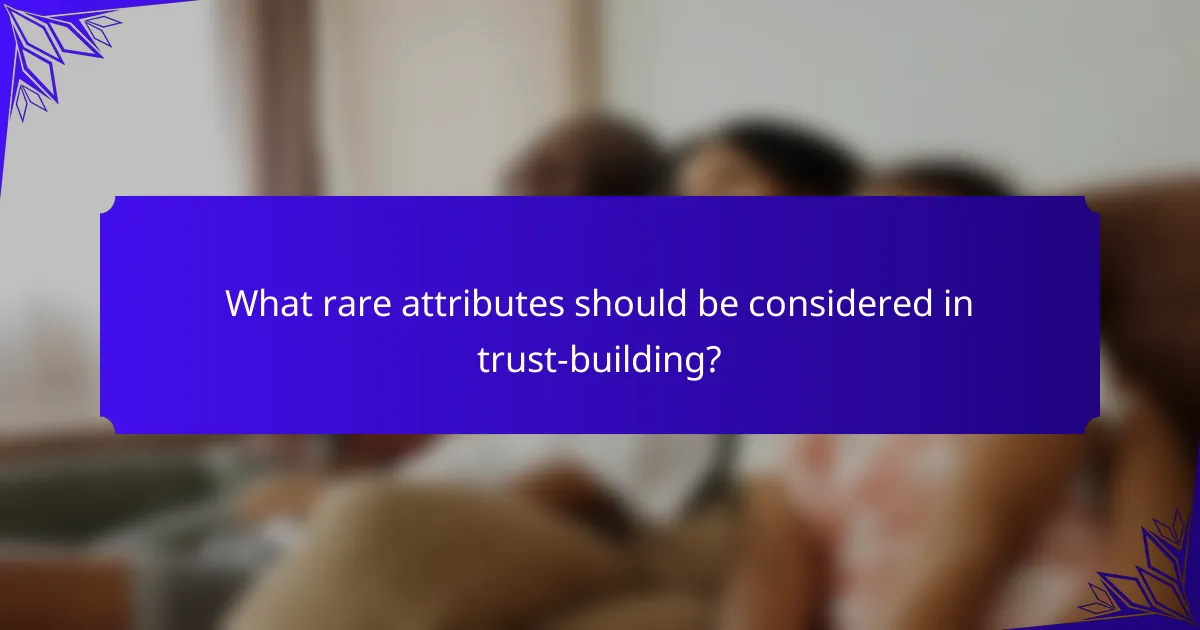
What rare attributes should be considered in trust-building?
To build trust in learning environments, consider rare attributes such as transparency, vulnerability, and consistency. Transparency fosters open communication, while vulnerability encourages authentic connections. Consistency reinforces reliability, creating a stable foundation for trust. These attributes enhance engagement and promote a positive learning atmosphere.
How does cultural awareness impact trust in diverse classrooms?
Cultural awareness significantly enhances trust in diverse classrooms. By recognizing and valuing different cultural backgrounds, educators foster an inclusive environment that promotes open communication and collaboration. This approach builds rapport among students, encouraging them to express themselves freely and engage with peers.
Understanding cultural nuances helps educators tailor their teaching strategies, making learning more relevant and relatable. For instance, incorporating culturally diverse materials can validate students’ experiences, reinforcing their sense of belonging. As a result, students are more likely to trust their educators and participate actively in the learning process.
Furthermore, cultural awareness can reduce biases and stereotypes, leading to a safer classroom atmosphere. When students feel respected and understood, they are more inclined to form positive relationships with their peers and teachers. This trust ultimately contributes to better academic performance and emotional well-being.
What are the implications of psychological safety in learning?
Psychological safety in learning fosters open communication, encouraging risk-taking and innovation. This environment enhances engagement, leading to improved learning outcomes. Trust-building strategies like active listening and constructive feedback are crucial. As a result, learners feel valued and motivated to participate, ultimately boosting their confidence and performance.
How can educators create a psychologically safe environment?
Educators can create a psychologically safe environment by fostering trust, encouraging open communication, and validating student contributions. These strategies promote engagement and enhance learning outcomes.
One effective approach is to establish clear expectations for respectful interactions. This sets a foundation for students to express themselves without fear of judgment. Additionally, providing constructive feedback helps students feel valued and understood.
Incorporating collaborative activities can further strengthen relationships among students, allowing them to support each other. Regular check-ins can also help educators gauge student comfort levels, enabling timely adjustments to the environment.
Ultimately, a focus on empathy and active listening cultivates a culture of safety and trust, essential for effective learning.
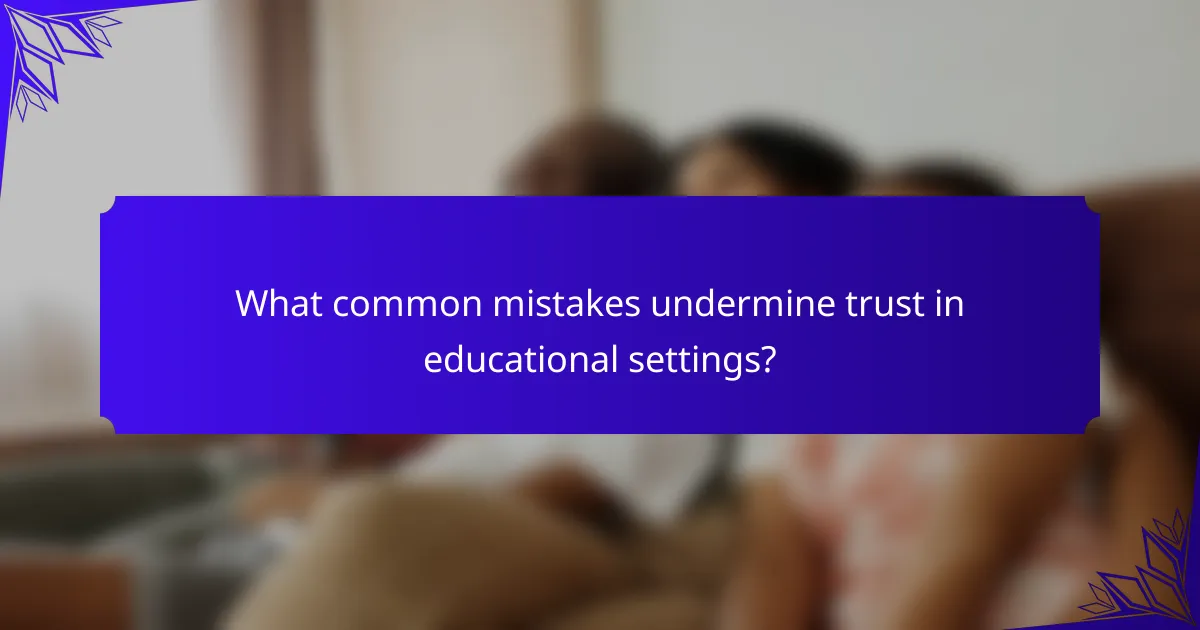
What common mistakes undermine trust in educational settings?
Common mistakes that undermine trust in educational settings include lack of transparency, inconsistent communication, failure to follow through on commitments, and ignoring student feedback. These behaviors can create an environment of skepticism and disengagement. For example, when educators do not share grading criteria, students may feel uncertain about their progress. As a result, trust erodes, impacting overall learning outcomes. Establishing clear expectations and maintaining open lines of communication can help mitigate these issues, fostering a more trustworthy educational environment.
How can miscommunication erode trust?
Miscommunication can significantly erode trust by creating misunderstandings and fostering skepticism. When messages are unclear, individuals may feel undervalued or ignored, leading to a breakdown in relationships. Additionally, repeated miscommunication can undermine confidence in the communicator’s reliability, causing a ripple effect of distrust within learning environments. As a result, effective communication strategies are essential for maintaining trust and promoting engagement.
What are the consequences of inconsistency in teaching?
Inconsistency in teaching leads to diminished trust, decreased student engagement, and hindered learning outcomes. Students may feel confused or frustrated, impacting their motivation. As a result, effective conditioning and engagement strategies become less effective. Establishing a reliable teaching approach fosters a stable learning environment, enhancing student performance and satisfaction.
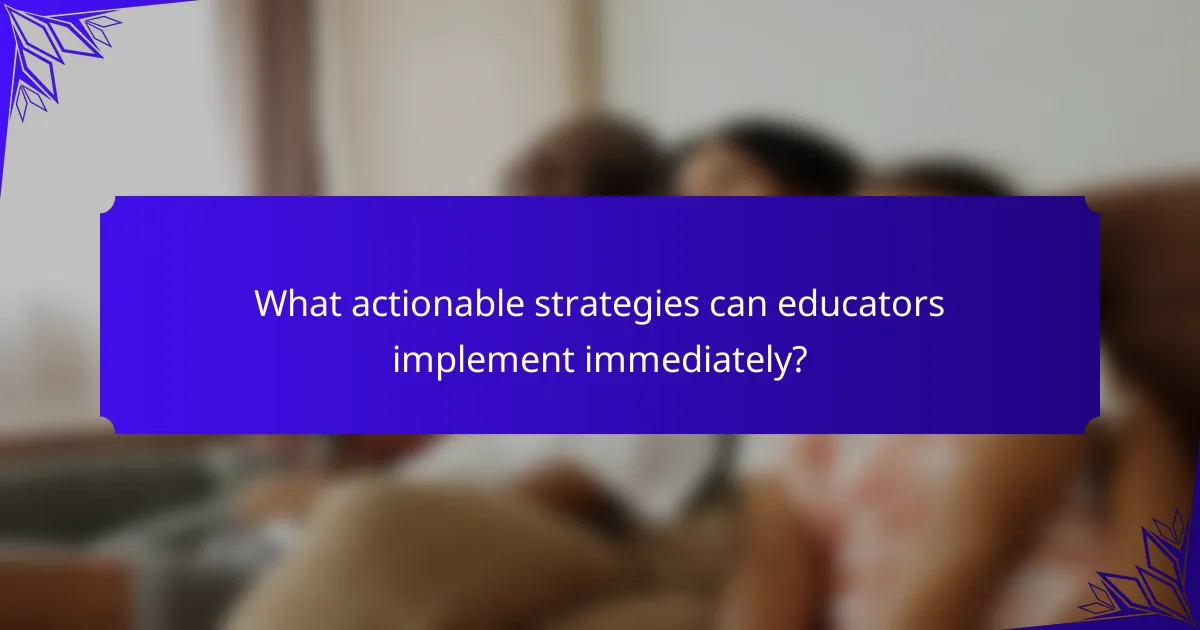
What actionable strategies can educators implement immediately?
Building trust in learning environments requires actionable strategies that educators can implement immediately. Establish clear communication by sharing expectations and being transparent about goals. Foster a supportive atmosphere by actively listening to students’ concerns and validating their feelings. Encourage collaboration through group activities, which can enhance peer relationships and trust. Finally, provide consistent feedback to reinforce positive behaviors and build confidence in students.
How can feedback loops strengthen trust?
Feedback loops can significantly strengthen trust by promoting transparency and accountability. When learners receive regular, constructive feedback, they feel valued and understood, fostering a sense of safety. This process encourages open communication, allowing individuals to express concerns and seek clarification. As a result, trust builds through consistent interactions and shared goals. Feedback loops reinforce positive behaviors, creating a culture of mutual respect and collaboration. Ultimately, this trust enhances engagement and improves learning outcomes, making feedback a critical component in effective educational environments.
What are the best practices for engaging students to build trust?
To build trust in learning environments, engage students through consistent communication, transparency, and active participation. Establishing a safe space encourages open dialogue and fosters relationships. Incorporate collaborative activities that promote teamwork and peer support. Regular feedback enhances student confidence and reinforces trust. Utilize personal anecdotes to create relatability and connection, making students feel valued and understood.
How can collaborative activities enhance engagement and trust?
Collaborative activities enhance engagement and trust by fostering open communication and shared goals. These interactions create a sense of community, encouraging participants to invest emotionally in the learning process. As a result, trust builds through mutual respect and understanding. Collaborative tasks also promote accountability, as individuals rely on each other to achieve common objectives. This interconnectedness leads to deeper relationships and a more supportive learning environment. Additionally, the diversity of perspectives in collaborative settings enriches discussions, further enhancing engagement and trust among participants.

